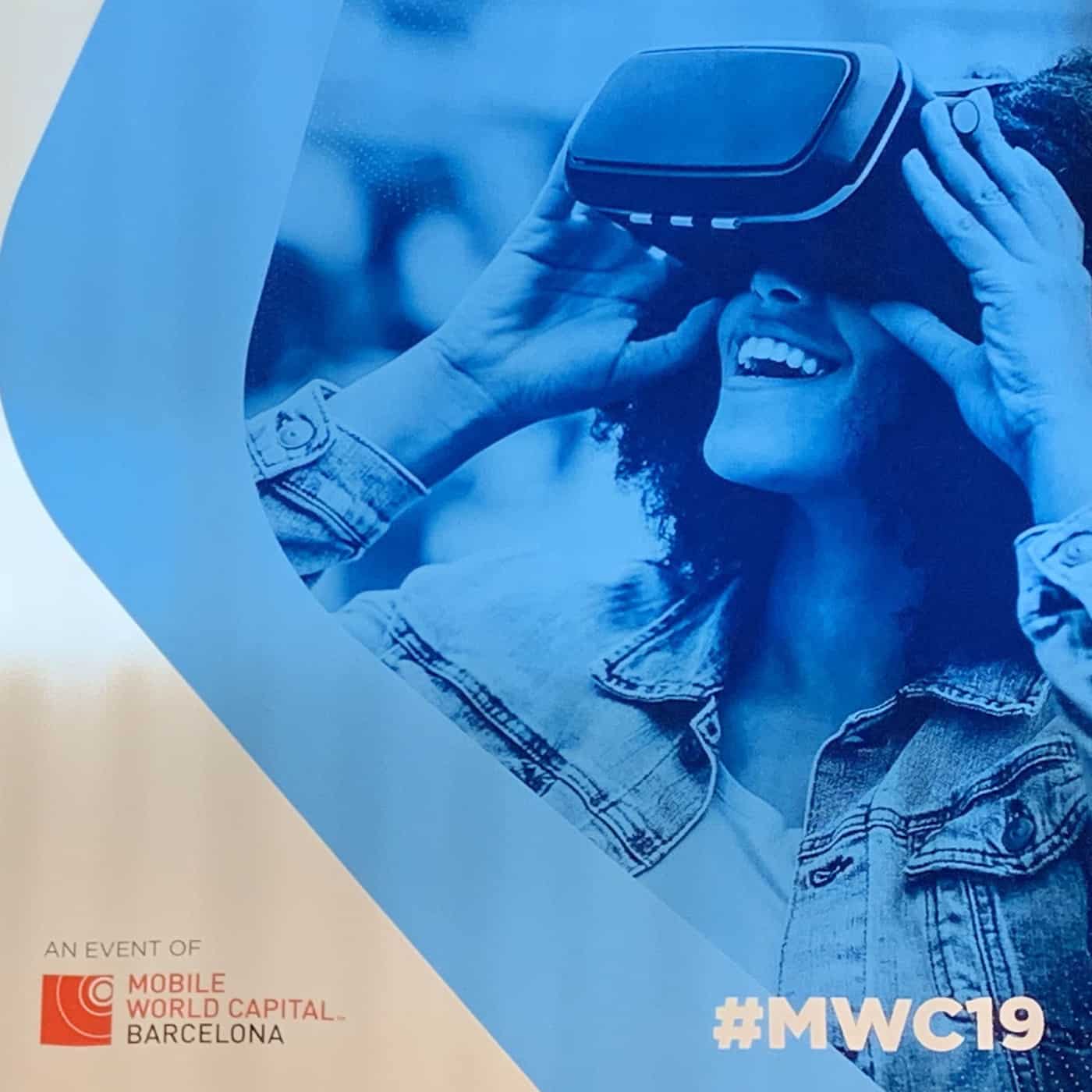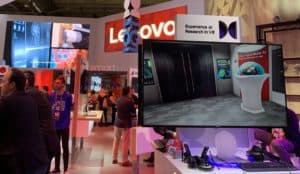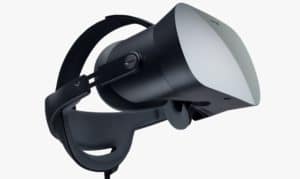

Unlike last year’s IBC and NAB conferences, where VR and AR demos were few and far between, this year’s Mobile World Congress in Barcelona featured a wide variety of immersive tech throughout the exhibit halls. Even the official graphics for the event – plastered on buses and billboards all over Barcelona – featured a VR user! I was there, wandering the enormous halls, so you didn’t have to be. Read on for my totally selective, biased and most likely incomplete take on the show…
Overall Impressions

For telcos and technology vendors, it seems the “trough of disillusionment” for VR is already past, or perhaps never happened at all. Nearly every major telco or equipment vendor had VR demos, AR demos, or both. Nokia and Intel featured a multiplayer Spider-Man game over 5G. These weren’t the only VR demos in the Nokia and Intel booths: Nokia also had a live feed over 5G (courtesy of Imeve Live, natch) and a terrific low-latency demo with a multiplayer table tennis game; Intel also had live viewport-adaptive streaming in their booth (courtesy of TiledMedia). Sony promoted real-time 360 in their messaging (although not with any actual running demos). Deutsche Telekom had a couple of VR demos including a social app with another booth. Lenovo featured a VR application on the floor and extensive use of VR in their billboard messaging. And it wasn’t just telcos either! BMW had a prominent VR presentation to introduce their new line of electric cars. And on and on. Of course Vive and Pico and other headset manufacturers had their displays, but what was striking to me was how much mainstream companies embraced immersive tech for this trade show.
I’m sorry to say that none of these demos really surprised me or blew me away. They were fine, some of them were quite good actually, but I didn’t see anything groundbreaking. It was clear, though, from the traffic on the floor why the marketing people were using it: the immersive demos were in high demand. People were lining up to see these demos. VR/AR is a great marketing tool for trade shows!
Headset Tech

The waiting is the hardest part … no, actually the tracking is the hardest part
The big news of course was Microsoft’s announcement of their forthcoming Hololens 2. The sizeable MSFT booth was almost 100% Hololens. After an hour-long wait (and this on the last day of the show!) I got to try a medical training demo, created by Pearson, in which I was supposed to diagnose a rather nervous-looking hologram with a heart attack. The functionality of the training program was rudimentary at best, with no interaction to speak of. But that wasn’t the point: the hardware was. You’ve probably read complete reviews that touch on the many improvements from Hololens. But I’ll mention one that most journalists missed: the tracking stability is freaking amazing. Hololens already had the best tracking stability in the business (Magic Leap included); Hololens 2 improves on it noticeably. In the busy trade floor with lots of moving objects and weird lighting, it was rock solid. By far the best tracking I’ve ever seen. IMHO this capability is maybe the most crucial part of the AR illusion: virtual objects must maintain their location!
I wouldn’t want to be Magic Leap, or honestly any other AR headset manufacturer at the moment. Microsoft has this dead nailed.
And yet others will try. I got to check out the NReal Light smartglasses at the Qualcomm booth. These are lightweight eyeglass-style glasses with integrated reflective displays. In concept they’re similar to Mira, except instead of clamping your smartphone to your head, they have their own embedded displays, and connect to your phone with a cable. Build quality was quite good, and of course field of view was good as well. But the tracking stability was pretty poor. An interesting concept, but at $1k it’s hard to see who this is for. Too expensive for consumers, and for industrial applications, why not just get a Hololens 2?
I also dropped in on Vuzix’s relatively big booth (for a smallish company) where they were showing off their new Blade AR glasses. They set up several imaginary scenarios – a street, an operating theater, a supermarket – where supposedly AR glasses would be useful. In each scenario, the glasses recognized something in the world and then showed you data. Pretty much the simplest possible use case, tarted up into several different versions.
I want to root for this company, as they hail from Western New York State just like me. But these glasses seemed from a previous generation. There was no AR to speak of – no SLAM, no room tracking, no object persistence – just a display in front of your face. But hey, they seem to be doing quite well so perhaps they’ve got the cash to transition their application suite onto a more modern hardware platform … like Hololens.

Finally there was Varjo, and while I didn’t stop by their booth, I did get a private demo of their headset at CES in January. Folks, all I can tell you is: it’s for real. Forget about the complex moving-mirror tech they talked about last year — they left it out. And I didn’t miss it. The high-resolution part of the display is at the center. If you want to look closely at something, you turn your head to look at it. Just like in real life. Doesn’t require anything unnatural. And what a display it is! I don’t know if it’s truly “human eye resolution” but it’s damn close. In their photogrammetry-captured scan of an artist’s studio, I was able to walk over to the bookshelf and read the spines of the CDs. The future of beautiful super-high-resolution VR experiences is closer than you think.
5G Mania
Of course, the headline for anyone who isn’t a VR/AR nerd like me is 5G. 5G, 5G, 5G, 5G. Even the taxi drones are 5G, apparently. Not that that makes any sense.
Will 5G make a difference for our industry? Yes. Eventually. We will eventually get an order of magnitude more bandwidth up and down. We will eventually get cloud-based graphics engines that can render AAA-quality output on mobile class devices. (Actually one of the best 5G demos I saw was tucked in a back corner of the Nokia booth and showed exactly this.) These things will make a huge difference for the kind of experiences we can eventually offer to consumers on a mass scale. But for all the talk about 5G being real this year, the fact is there are some serious technical challenges remaining, the rollouts will be slow, and these great advances won’t be hitting your average user for years to come.
The best thing about 5G for our industry is that these big companies believe in 5G, and they believe – correctly – that VR and AR use cases are a good way to demonstrate the promise of their new technology. And they’re putting their substantial marketing and R&D budgets behind it. And right now, as a mild winter starts to set in for AR while the first signs of spring are appearing for VR, that support is very helpful.


